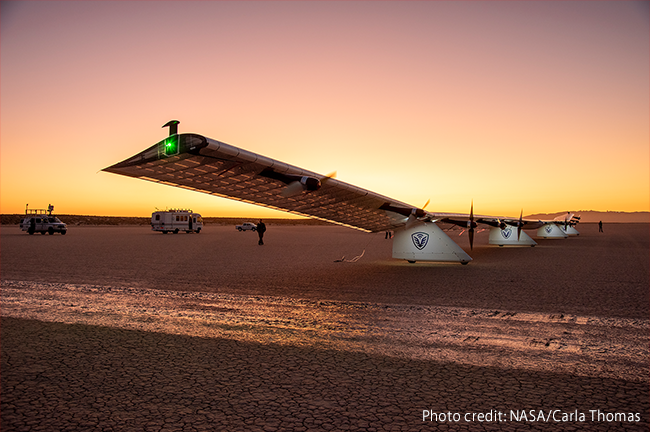Sunglider solar driven unmanned aerial system reaches new heights achieving over 62,000 feet in altitude on test flight
High Altitude Pseudo-Satellites (HAPS) from a number of manufacturers are undergoing tests as alternatives to earth orbit satellites for military and defence purposes as well as providing broadband in areas of the world without coverage.
One such HAPS is the “Sunglider” aircraft, a solar powerd unmanned aerial system (UAS) produced by HAPSMobile and AeroVironment. Towards the end of 2020, the consortium flew the vehicle under test from Spaceport America in New Mexico, achieving an altitude of 62,500 feet (approximately 19km).
Designed as a sub-orbital platform system for telecommunications, the unmanned Sunglider is intended for long period flights to provide sustained communications. On this occasion, the flight lasted a total of just over 20 hours with 5 hours and 30 minutes of that time being spent in the stratosphere zone. The zone presented the UAS with extremely demanding conditions with temperatures plummeting to lows of -73C and wind speeds of up to 58 knots or around 30 meters per second.
Using all-electric power, the Sunglider was launched on a pre-flight battery charge and had to use just solar energy to maintain its flight. The UAS has a wingspan of 262 feet and is propelled by 10 electric motors powered by solar panels covering the surface of the wing and rechargeable battery packs, resulting in zero emissions. It can carry payloads weighing as much as 150 pounds and is designed for continuous, extended missions of months without landing.
According to Sunglider’s manufacturer, AeroVironment, the vehicle successfully achieved major test objectives relating to propulsion, power systems, flight control, navigation and datalink integrity, as well as structural performance during the most turbulent phases of the flight as it entered and exited the jet stream.
Speaking after the successful flight, AeroVironment’s president and CEO, Wahid Nawabi noted that in the less than three years since the project started, the company and HAPSMobile had jointly made incredible progress, developing two Sunglider solar HAPS unmanned aircraft and performing five consecutive flight demonstrations, culminating in this latest milestone.
“Reaching stratospheric altitude, maintaining continuous flight for more than 20 hours, achieving key test objectives and demonstrating seamless broadband communication illustrate the tremendous potential HAPS technology offers to expand connectivity globally,” he says.
For the Sunglider to be viable as a commercial project, it will need to overcome the hurdle of certification. The advantage of stratospheric balloons not requiring certification isn’t currently shared with UAVs and so Sunglider will need aircraft authorisation in order to be able to fly missions.
“We look forward to maintaining our momentum towards aircraft certification and commercialization, working in close partnership with HAPSMobile as we establish a new capability that offers tremendous value,” says Nawabi.
Communication Payload
In addition to reaching the stratospheric flight milestone, an Internet connectivity test using a communications payload jointly developed with Loon was successfully performed during the test flight. Using smartphones connected to the Internet through the payload in the stratosphere, members from Loon and AeroVironment successfully made a video call to HAPSMobile members based in Japan.
The stratosphere-ready payload used in the test flight was a first-of-its-kind for a fixed-wing, autonomous aircraft-based HAPS to deliver LTE connectivity. Using MIMO technology, the payload enabled LTE connectivity to be delivered continuously for approximately 15 hours during Sunglider’s test flight.
The payload test system was composed of a service link from Sunglider using the 700MHz spectrum band (LTE Band28) and a feeder link between the aircraft and a ground gateway using millimeter wave spectrum. Since the radio waves transmitted and received by Sunglider operate on the same frequencies as existing smartphones and devices, Loon and AeroVironment members were able to use regular smartphones to participate in the video call. During the test flight, smooth operations and connection speeds enabled high-definition, low-latency video calls.
During the test flight, HAPSMobile also conducted basic measurements of stratosphere-to-ground radio wave propagation data that will be used toward future contributions to the ITU Radiocommunication Sector (ITU-R) with a view to international standardization. With the valuable data that the teams collected during this test, HAPSMobile and Loon will be collectively working with ITU, 3GPP, regulators and telecommunication companies to further the existing work on HAPS. The test also provided insight into how HAPS could be used in disasters and alongside other lifesaving technologies.
According to Junichi Miyakawa, President & CEO of HAPSMobile, vital data was obtained that will accelerate the development of commercial services and improve the coverage and quality of HAPS connectivity.
“I am thrilled that our wireless communications equipment jointly developed with Loon exceeded our expectations in severe high-altitude conditions. We look forward to further developing the payload so we can improve mobile connectivity and bridge the world’s digital divide,” he says.
Loon’s CEO Alastair Westgarth said, “This successful test represents yet another step to develop a new layer of connectivity based in the stratosphere. It is also an important step in our ongoing strategic partnership with HAPSMobile. By developing technologies to harness the opportunity of the stratosphere, we are making progress toward our shared goal of connecting unconnected and under-connected populations around the world.”
Miyakawa believes that the company has once again moved a step closer to its goal of building a base station that floats in the sky solely on the basis of solar power.
With the high wind speeds on the day of the test, Miyakawa was relieved when it hit the runway after clearing all the test items.
“In this test flight, we successfully conducted communications with smartphones on the ground and obtained data for fully automated piloting. While there is still much room for improvement, we will continue to work toward realising our dream. Even though the temperature fell below 73 degrees Celsius, our work on endurance tests bore fruit and resulted in a successful test flight,” he concluded.

